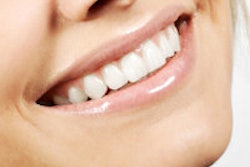
At-home whitening produces similar results to in-office whitening at far less expense, according to a randomized study involving 20 subjects (Operative Dentistry, July 2010, Vol. 35:4, pp. 381-388).
The researchers literally flipped a coin to determine whether the subjects' right or left maxillary anterior teeth would be whitened using the in-office Zoom AP (Discus Dental) system, involving 25% hydrogen peroxide exposure for one hour. The subjects' other teeth were treated using eight hours of exposure to dentist-prescribed Nite White Excel 3 (3% to 10% CP, Discus Dental) via an at-home overnight tray method.
Six days after the treatment with the in-office whitening system and the first night of at-home whitening, the subjects' teeth had achieved similar whitening, as measured by the Vita Bleachedguide 3D-Master (BSG, Vita Zahnfabrik) and a spectrophotometer (ES-Easyshade, Vident).
Furthermore, all of the subjects responded in the affirmative when they were asked whether they would recommend the at-home procedure to a friend, while only 63% answered yes when asked about recommending in-office whitening to a friend (p = 0.012).
These findings differed slightly from a 2009 study led by Bruce Matis, D.D.S., M.S.D., although he and his colleagues also found that dentist-prescribed overnight bleaching is more effective than in-office bleaching at the end of six weeks (Operative Dentistry, March 2009, Vol. 34:2, pp. 230-235).
"Our results are a little different than those of the newer study, since we didn't examine patient satisfaction," Dr. Matis told DrBicuspid.com. "I will follow with interest other clinical studies that are published to see what they show."
Split-mouth study
In the current study, lead investigator Juliana da Costa, D.D.S., M.S., an associate professor of restorative dentistry at Oregon Health and Science University, and three co-investigators gave each patient a dental cleaning to remove any extrinsic stains. Then they applied at-home and in-office whitening to the maxillary anterior teeth, using randomization to determine which of the teeth received each form of treatment.
For the in-office whitening, they first applied Liquidam (Discus Dental) to the soft tissue to isolate and protect it. They then applied the Zoom AP 25% hydrogen peroxide gel for a total of one hour, following the manufacturers' instructions.
For at-home whitening, patients received a half-arch tray, the Nite White Excel 3% to 10% hydrogen peroxide whitening gel, and instructions for its use. The patients were told to place the whitening gel in the half-arch tray and only whiten those teeth overnight for eight hours. They were instructed to remove the tray from their mouths in the morning, swab away the residue gel, then brush their teeth and the tray with cold water. They were asked to repeat this protocol five days in a row.
The researchers measured the subjects' tooth color at days one, six, and 20. After one in-office whitening treatment, those teeth that were subjected to this treatment became brighter than at baseline, the researchers reported. By six days, after the patients had given the other teeth the at-home whitening treatment, the two sets of teeth had undergone a similar degree of whitening. This persisted to day 20, according to the study authors. Furthermore, none of the subjects experienced tooth or gingival sensitivity at 20 days.
Survey says ...
The researchers also gave their subjects questionnaires designed to provide information about their experience with the whitening. Nineteen of the 20 patients completed and submitted the surveys. Overall, the subjects said they were satisfied with the results of both forms of whitening, while a lower percentage reported their experience was what they expected with the office whitening than with the at-home approach.
Furthermore, while 80% of the patients found the office procedure comfortable, 74% reported preferring the at-home procedure and 28% said in-office whitening was superior. And while 63% said they would recommend office whitening to a friend, all of them said they would recommend at-home whitening (p = 0.012).
The investigators also noted in their write-up of the results that in-office tooth whitening "costs almost twice as much as at-home treatment and usually needs to be followed by at-home treatment to achieve the whitening effect expected by patients." They recommend more studies of tooth-color change with the two approaches, with follow-up for months instead of weeks to evaluate the full and final effects of each.
Copyright © 2010 DrBicuspid.com



















